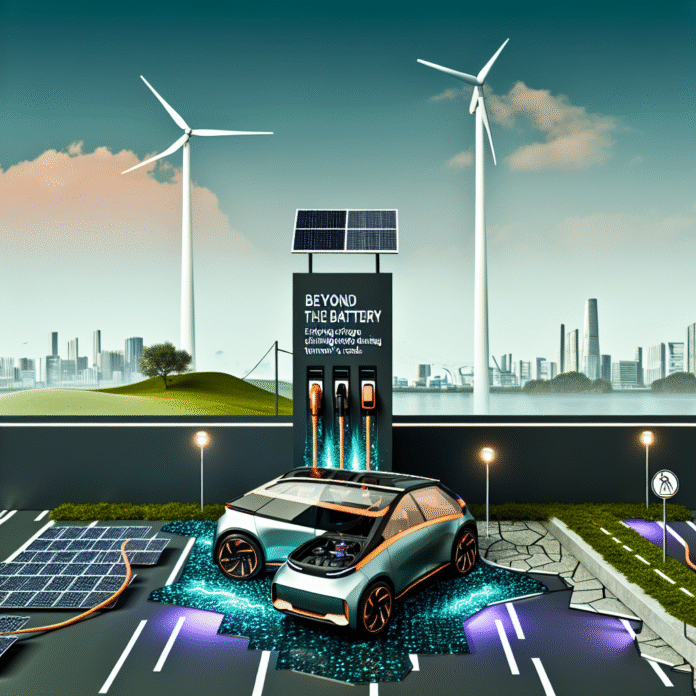Beyond the Battery: Exploring Cutting-Edge EV Technologies Shaping Tomorrow’s Roads
Imagine cruising down a serene highway, the sun glistening off your electric vehicle (EV), when suddenly you realize: what lies beyond the battery? Sure, batteries are the heart of EVs, but there’s an entire ecosystem of innovative technologies and ideas making future roads smarter, safer, and more exciting. Today, let’s take a thrilling ride beyond the typical narratives and dive into what’s next for electric vehicles and how these advancements are reshaping the driving experience.
The Road Ahead: Smart Infrastructure
Ever thought about what makes a car truly “smart”? It’s not just the gadgetry inside. It’s the surrounding infrastructure. Imagine highways embedded with sensors capable of communicating with your EV, predicting traffic patterns, and even adjusting the speed limits accordingly. This “smart infrastructure” plays a crucial role in today’s EV revolution.
Take, for example, the concept of “Vehicle-to-Everything” (V2X) communication, where your car interacts with traffic lights, road signs, and even pedestrians. This connectivity can reduce traffic congestion, increase safety, and enhance energy efficiency. In cities like Los Angeles, pilot programs are already testing these technologies, demonstrating how a more integrated transport system could make commuting a breeze, while also reducing the road’s carbon footprint.
Wireless Charging: Power Up on the Go
Picture this: you pull into a parking space, and rather than fumbling with cables, your car begins to charge wirelessly. This isn’t just sci-fi fantasy; it’s a growing reality. Wireless charging pads embedded in parking lots or along busy roadways can charge EVs as they stop, making owning an electric vehicle even more convenient.
Charging giants like WiTricity are pioneering this technology, focusing on high-efficiency charging solutions. Imagine running errands without the usual “range anxiety,” as your vehicle taps into a charging network seamlessly. This could redefine how we think about fuel stops—turning them into mere pauses in our journey rather than a chore.
Autonomous Driving: The Future of Commuting?
Autonomous driving technology is another exciting frontier that complements EV advancements. Think of how much time we spend behind the wheel. What if that time could be spent reading, working, or just relaxing? Major companies, like Tesla and Waymo, are consistently pushing boundaries, testing vehicles that navigate using complex algorithms and real-time data.
But is it safe? Trials are showing promising results. Cities are being equipped with improved sensors and cameras, designed to support these autonomous vehicles. The smooth integration of electric and autonomous driving may someday create cities with fewer accidents, less pollution, and more efficient traffic flow. Imagine a world where your car picks you up and drops you off safely, while you sit back and enjoy your favorite podcast!
The Rise of Solid-State Batteries
While we’ve discussed the thrilling possibilities beyond batteries, let’s not forget that improvements to battery technology itself are monumental. Solid-state batteries are emerging as a game changer—the next step in energy storage. Unlike traditional lithium-ion batteries, which use liquids, solid-state batteries rely on solid electrolytes. This innovation promises increased energy density, faster charging times, and greater safety.
Companies like Toyota and QuantumScape are racing to bring these batteries to market. Why does this matter? Greater efficiency translates into longer driving ranges and a reduced need for charging stops. In a world where convenience is king, solid-state batteries might just become the ultimate solution to our EV travel woes.
Recycling and Sustainability: A Circular Economy
With all this talk about EV technologies, it’s also vital to address the environmental impact of battery production and disposal. Recycling has become an integral part of creating sustainable practices within the automotive industry. The goal is to establish a circular economy, where materials used in batteries are reclaimed and reused, minimizing waste.
Firms like Redwood Materials are stepping up to the plate, focusing on harvesting valuable materials from old EV batteries, like lithium, cobalt, and nickel. This not only alleviates mining demands but also ensures that the EV industry remains eco-friendly. In a sense, it’s about repurposing the past to drive the future.
The Human Element: Driving Experience and Community
Finally, let’s not overlook the importance of the driver’s experience and community-building. Today’s consumers are looking for more than just a car; they want an experience. Brands like Tesla have mastered the art of creating community. Owners often share tips, engage in forums, and even participate in events. The social aspect adds another layer to the ownership experience.
Moreover, as EV technologies evolve, manufacturers are designing vehicles that cater to user preferences, incorporating smart interfaces and personalized driving profiles. The next-gen EVs won’t just be about sustainability; they’ll be about community, comfort, and connection, growing our interaction with technology on a personal level.
Final Thoughts
As we cruise down the road of innovation, the potential for electric vehicles expands beyond just the batteries bolting them to life. Smart infrastructure, wireless charging, autonomous driving, advanced battery technology, recycling practices, and community engagement are all pieces of a puzzle that creates a more sustainable and exciting travel experience. The future promises not only to enhance how we drive but also how we connect, live, and interact within our communities. As technology and creativity continue to push the limits, tomorrow’s roadways could very well resemble a thrilling playground of possibilities.
With all these advancements on the horizon, the landscape of electric vehicles is not just evolving; it’s transforming into something truly extraordinary. Buckle up; the journey has only just begun!
Learn more about smart infrastructure: Smarter Transportation
Discover wireless charging solutions: WiTricity
Explore autonomous driving innovations: Tesla
Read about solid-state battery advancements: Toyota
Find out more about recycling efforts: Redwood Materials

